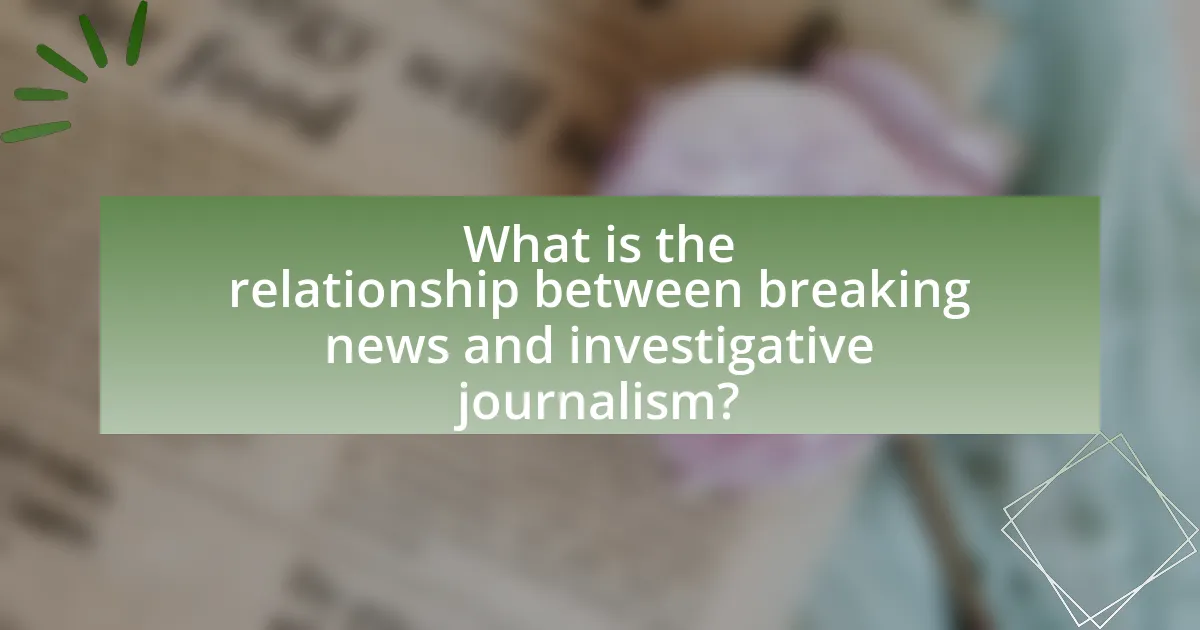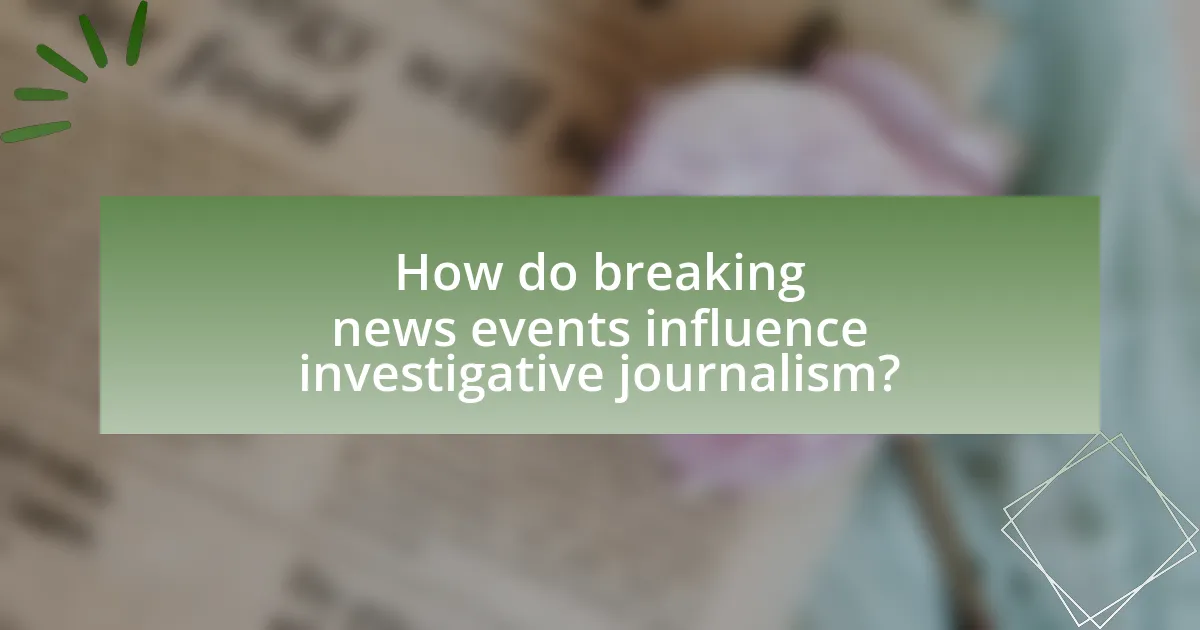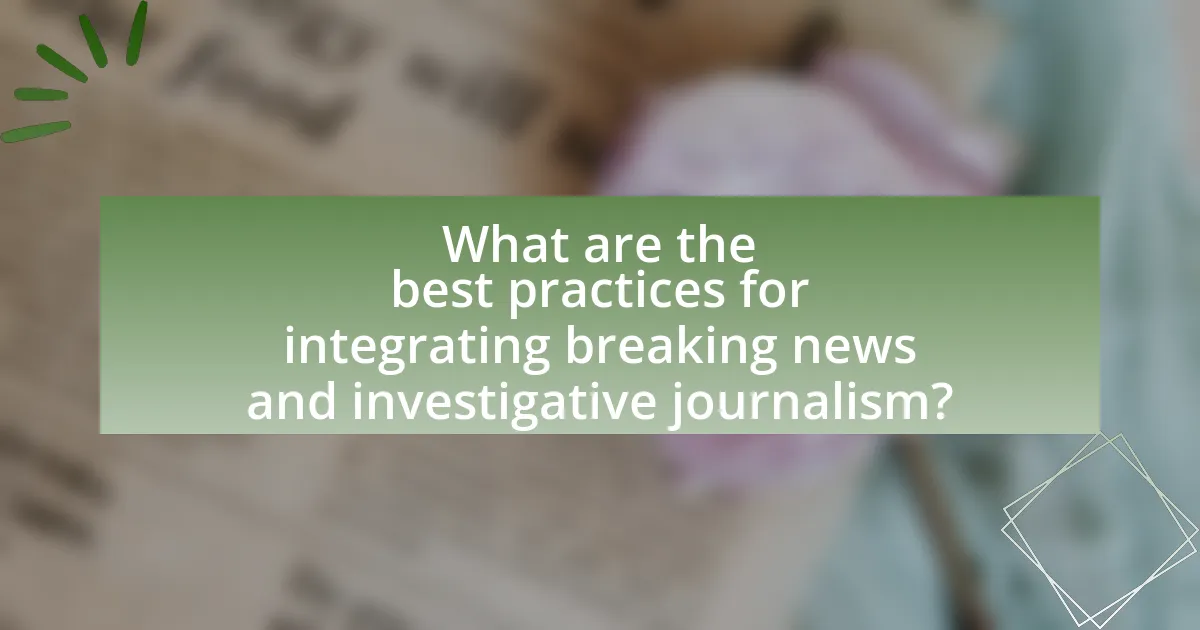The article examines the relationship between breaking news and investigative journalism, highlighting their distinct roles in informing the public. Breaking news delivers immediate updates on current events, prioritizing speed and accuracy, while investigative journalism focuses on in-depth research to uncover hidden truths and hold power accountable. The interplay between these two forms of journalism is crucial, as breaking news can prompt further investigations, leading to a deeper understanding of significant issues. The article also discusses the challenges faced by both types of journalism, including ethical dilemmas and resource allocation, and emphasizes best practices for integrating timely reporting with thorough investigative work.

What is the relationship between breaking news and investigative journalism?
Breaking news and investigative journalism are interconnected as both serve to inform the public, but they operate in distinct ways. Breaking news focuses on delivering immediate information about current events, often prioritizing speed over depth, while investigative journalism involves in-depth research and analysis to uncover hidden truths, often taking weeks or months to produce. The relationship lies in how breaking news can sometimes prompt investigative journalism; for instance, a significant event reported as breaking news may lead journalists to conduct further investigations to explore underlying issues or implications, as seen in cases like the Watergate scandal, where initial reports led to extensive investigative work revealing corruption.
How do breaking news and investigative journalism differ in their objectives?
Breaking news and investigative journalism differ primarily in their objectives; breaking news aims to provide immediate updates on current events, while investigative journalism seeks to uncover deeper truths and hold power accountable. Breaking news focuses on delivering timely information, often prioritizing speed and accuracy to inform the public about unfolding events, such as natural disasters or political developments. In contrast, investigative journalism involves extensive research, interviews, and analysis to expose issues like corruption or systemic injustices, often taking weeks or months to produce a comprehensive report. This distinction highlights the urgency of breaking news against the thoroughness of investigative work, emphasizing their unique roles in informing the public.
What are the primary goals of breaking news reporting?
The primary goals of breaking news reporting are to inform the public about urgent events, provide timely updates, and ensure accuracy in the dissemination of information. Breaking news serves to deliver critical information quickly, often in real-time, to keep the audience aware of significant developments, such as natural disasters, political events, or emergencies. The urgency of breaking news reporting necessitates a focus on speed while maintaining factual integrity, as seen in major news outlets that prioritize immediate coverage of unfolding stories. This approach is essential for public safety and awareness, as timely information can influence decision-making and responses in crisis situations.
What are the key objectives of investigative journalism?
The key objectives of investigative journalism are to uncover the truth, hold power accountable, and inform the public about issues of significant concern. Investigative journalism seeks to expose corruption, fraud, and abuse of power by conducting thorough research, interviews, and analysis. For instance, the Watergate scandal investigation by journalists Bob Woodward and Carl Bernstein led to the resignation of President Richard Nixon, demonstrating the impact of investigative journalism in holding leaders accountable. This form of journalism plays a crucial role in a democratic society by ensuring transparency and fostering informed citizenry.
Why is the relationship between breaking news and investigative journalism important?
The relationship between breaking news and investigative journalism is important because it ensures timely dissemination of critical information while maintaining accountability in reporting. Breaking news captures immediate events that require urgent attention, while investigative journalism delves deeper into issues, uncovering truths that may not be apparent in the moment. This synergy allows the public to stay informed about current events while also understanding the underlying factors and implications, as seen in cases like the Watergate scandal, where initial breaking news led to extensive investigative reporting that revealed systemic corruption. Thus, the interplay between these two forms of journalism enhances the overall integrity and depth of news coverage.
How does breaking news impact the public’s perception of investigative journalism?
Breaking news significantly influences the public’s perception of investigative journalism by creating a heightened awareness and urgency around current events. When breaking news occurs, audiences often turn to investigative journalism for deeper insights and context, which can enhance the credibility and importance of such reporting. For instance, a study by the Pew Research Center found that 62% of Americans believe investigative journalism is essential for democracy, particularly during times of crisis when breaking news stories emerge. This suggests that breaking news can elevate the perceived value of investigative journalism as a critical tool for understanding complex issues.
What role does investigative journalism play in enhancing breaking news stories?
Investigative journalism plays a crucial role in enhancing breaking news stories by providing in-depth analysis and context that elevate the initial reporting. This type of journalism uncovers hidden truths, verifies facts, and exposes corruption or wrongdoing, which can significantly enrich the narrative of a breaking news event. For instance, during the Watergate scandal, investigative reporting by journalists Bob Woodward and Carl Bernstein revealed critical details that transformed a political break-in into a major national crisis, demonstrating how thorough investigation can reshape public understanding and response to breaking news.
What challenges do breaking news and investigative journalism face in their relationship?
Breaking news and investigative journalism face significant challenges in their relationship, primarily due to the differing priorities and timelines of each form of reporting. Breaking news emphasizes speed and immediacy, often prioritizing the rapid dissemination of information over thorough fact-checking, which can compromise accuracy. In contrast, investigative journalism requires extensive research, verification, and time to uncover deeper truths, which can be at odds with the fast-paced nature of breaking news. This tension can lead to incomplete or rushed reporting in breaking news scenarios, potentially undermining the credibility of both forms of journalism. Furthermore, the pressure to produce breaking news can divert resources and attention away from long-term investigative projects, limiting the depth and quality of reporting in both areas.
How does the fast-paced nature of breaking news affect investigative reporting?
The fast-paced nature of breaking news significantly hampers investigative reporting by prioritizing speed over depth. Journalists often rush to publish stories to meet immediate audience demand, which can lead to incomplete or inaccurate information being disseminated. For instance, during major events like natural disasters or political scandals, the urgency to report can overshadow the thorough fact-checking and comprehensive analysis that investigative journalism requires. This shift in focus can result in a reliance on superficial coverage rather than the in-depth scrutiny that characterizes investigative work, ultimately affecting the quality and reliability of the news being reported.
What ethical dilemmas arise when balancing breaking news and investigative journalism?
The ethical dilemmas that arise when balancing breaking news and investigative journalism include the potential for misinformation and the prioritization of speed over accuracy. Breaking news often requires immediate reporting, which can lead to the dissemination of unverified information, risking public trust and safety. Investigative journalism, on the other hand, emphasizes thorough research and fact-checking, which can delay reporting and miss the urgency of current events. This tension can result in journalists facing pressure to compromise ethical standards, such as accuracy and fairness, in favor of rapid reporting. For instance, the 2016 election coverage highlighted instances where news outlets rushed to publish stories without adequate verification, leading to significant public misinformation.

How do breaking news events influence investigative journalism?
Breaking news events significantly influence investigative journalism by shifting the focus of media resources and public interest towards urgent issues. When a major event occurs, such as a natural disaster or political scandal, investigative journalists often pivot their efforts to uncover deeper stories related to the event, driven by heightened public demand for information. For instance, the Watergate scandal in the 1970s exemplified how a breaking news event led to extensive investigative reporting that revealed systemic corruption, ultimately resulting in significant political consequences. This dynamic illustrates that breaking news not only catalyzes immediate reporting but also opens avenues for in-depth investigations that can reshape public discourse and accountability.
What are the immediate effects of breaking news on investigative journalism?
Breaking news significantly impacts investigative journalism by shifting focus and resources towards immediate reporting rather than in-depth investigations. This shift often leads to a prioritization of sensational stories over comprehensive analysis, as journalists rush to provide timely updates. For instance, during major events like natural disasters or political scandals, newsrooms may allocate more personnel to cover the unfolding situation, which can delay or halt ongoing investigative projects. Research indicates that this phenomenon can result in a decrease in the quality and quantity of investigative reporting, as seen during the 2016 U.S. presidential election when breaking news cycles dominated media coverage, overshadowing long-term investigative efforts.
How do journalists prioritize stories during breaking news events?
Journalists prioritize stories during breaking news events by assessing the urgency, impact, and relevance of the information. They focus on immediate threats to public safety, significant developments, and events that affect a large audience. For example, during a natural disaster, journalists will prioritize reports on evacuation orders and safety information over less urgent updates. This prioritization is guided by journalistic ethics and the need to provide timely, accurate information to the public, ensuring that critical news reaches audiences quickly.
What resources are allocated to investigative journalism during breaking news?
Investigative journalism during breaking news is allocated resources such as dedicated reporters, specialized editors, and access to real-time data analytics. News organizations often assign experienced journalists to cover breaking stories, ensuring that they can quickly gather and verify information. Additionally, financial resources may be directed towards technology tools that facilitate data collection and analysis, enhancing the depth of investigative reporting. For instance, a study by the Pew Research Center indicates that newsrooms increasingly invest in digital tools to support investigative efforts, reflecting a commitment to thorough reporting even amid fast-paced news cycles.
How can breaking news lead to new investigative stories?
Breaking news can lead to new investigative stories by uncovering immediate events that reveal deeper issues or systemic problems. For instance, a sudden incident, such as a corporate scandal or a public safety crisis, often prompts journalists to dig deeper into the circumstances surrounding the event. This initial coverage can expose patterns of misconduct, corruption, or negligence that warrant further investigation. Historical examples include the Watergate scandal, where initial reporting on a break-in led to a comprehensive investigation revealing widespread political corruption. Such cases demonstrate how breaking news serves as a catalyst for uncovering significant stories that require thorough examination and reporting.
What types of breaking news often trigger investigative inquiries?
Types of breaking news that often trigger investigative inquiries include major political scandals, significant corporate malfeasance, high-profile criminal cases, and large-scale public health crises. These events typically involve allegations of wrongdoing or misconduct that warrant deeper examination. For instance, the Watergate scandal led to extensive investigative journalism that uncovered abuses of power within the U.S. government. Similarly, the Enron scandal prompted investigations into corporate fraud, revealing systemic issues in financial practices. Such breaking news stories often provide the impetus for journalists to pursue in-depth investigations, as they highlight potential violations of ethics, law, or public trust.
How do journalists identify potential investigative angles from breaking news?
Journalists identify potential investigative angles from breaking news by analyzing the context, sources, and implications of the event. They assess the details surrounding the news, such as who is involved, what has occurred, and why it matters, which helps them uncover deeper stories. For instance, if a breaking news event involves a public official, journalists may investigate the official’s past actions, financial records, or connections to other entities to reveal potential corruption or misconduct. This method is supported by the practice of following leads and corroborating information with multiple sources, ensuring that the angles pursued are grounded in factual evidence and relevance to the public interest.

What are the best practices for integrating breaking news and investigative journalism?
The best practices for integrating breaking news and investigative journalism include maintaining a clear distinction between the two while ensuring timely updates on ongoing investigations. Journalists should prioritize accuracy and context in breaking news reports, providing essential information without compromising the depth of investigative work. For instance, the Society of Professional Journalists emphasizes the importance of verifying facts before publication, which is crucial in both breaking news and investigative contexts. Additionally, collaboration between reporters specializing in breaking news and those focused on investigative pieces can enhance the overall quality and depth of coverage, as seen in successful newsrooms that employ cross-functional teams. This approach not only enriches the narrative but also fosters a comprehensive understanding of complex issues, ultimately benefiting the audience.
How can journalists effectively balance breaking news coverage with investigative work?
Journalists can effectively balance breaking news coverage with investigative work by prioritizing time management and resource allocation. By establishing a clear editorial strategy that delineates urgent breaking news from long-term investigative projects, journalists can ensure that both areas receive adequate attention. For instance, newsrooms can implement a rotating schedule where dedicated teams focus on breaking news while others concentrate on investigative reporting, allowing for continuous coverage without sacrificing depth. Research indicates that news organizations that adopt structured workflows and collaborative approaches tend to produce higher-quality journalism across both domains, as seen in the practices of major outlets like The New York Times and ProPublica.
What strategies can be employed to ensure thoroughness in both types of journalism?
To ensure thoroughness in both breaking news and investigative journalism, journalists should employ strategies such as comprehensive fact-checking, utilizing multiple credible sources, and maintaining a clear editorial process. Comprehensive fact-checking involves verifying information against reliable databases and expert opinions, which is crucial in breaking news to prevent the spread of misinformation. Utilizing multiple credible sources enhances the reliability of the information presented, as corroboration from different perspectives strengthens the narrative. Additionally, maintaining a clear editorial process, which includes peer reviews and editorial oversight, ensures that the content meets high standards of accuracy and integrity. These strategies are supported by the Society of Professional Journalists’ Code of Ethics, which emphasizes the importance of accuracy and accountability in journalism.
How can news organizations support their journalists in this balance?
News organizations can support their journalists in balancing breaking news and investigative journalism by providing adequate resources, training, and a supportive work environment. By allocating dedicated time for investigative projects and ensuring access to research tools, organizations enable journalists to delve deeper into stories without the pressure of immediate deadlines. Furthermore, fostering a culture that values in-depth reporting alongside timely news coverage encourages journalists to pursue comprehensive narratives. Research indicates that organizations that prioritize both aspects see improved job satisfaction and higher quality reporting, ultimately benefiting the audience and the integrity of journalism.
What lessons can be learned from successful integrations of breaking news and investigative journalism?
Successful integrations of breaking news and investigative journalism demonstrate the importance of timely reporting combined with in-depth analysis. This integration allows news organizations to provide immediate context to unfolding events, enhancing audience understanding and engagement. For instance, during the Watergate scandal, the Washington Post’s breaking news coverage was complemented by extensive investigative reporting, which ultimately led to significant political consequences. This case illustrates that blending immediate news with thorough investigation can lead to greater accountability and informed public discourse. Additionally, successful integrations often rely on collaboration among journalists, leveraging diverse skills to enhance storytelling and fact-checking, which strengthens the credibility of the news presented.
What case studies exemplify effective collaboration between breaking news and investigative journalism?
One prominent case study exemplifying effective collaboration between breaking news and investigative journalism is the coverage of the Watergate scandal by The Washington Post. During the early 1970s, reporters Bob Woodward and Carl Bernstein provided breaking news updates on the unfolding political scandal while simultaneously conducting in-depth investigative reporting that uncovered the extent of the Nixon administration’s involvement in the cover-up. Their work led to significant political consequences, including the resignation of President Richard Nixon in 1974. This case illustrates how timely reporting on breaking news can complement thorough investigative efforts, ultimately leading to greater public accountability and transparency.
How can these lessons be applied to future reporting practices?
Lessons from the relationship between breaking news and investigative journalism can be applied to future reporting practices by emphasizing the importance of thorough fact-checking and context in urgent news situations. For instance, the rapid dissemination of information during breaking news can lead to misinformation; therefore, implementing structured verification processes can enhance accuracy. Historical examples, such as the misreporting during the Boston Marathon bombing in 2013, illustrate the consequences of inadequate verification. By prioritizing accuracy and context, future reporting can maintain credibility and public trust, ensuring that urgent news does not compromise journalistic integrity.
What practical tips can journalists follow to enhance their work in both areas?
Journalists can enhance their work in both breaking news and investigative journalism by prioritizing accuracy and thorough research. Ensuring that all information is verified before publication helps maintain credibility, which is crucial in both areas. For instance, a study by the Pew Research Center found that 62% of Americans believe that accuracy is the most important quality in news reporting. Additionally, journalists should develop strong relationships with sources to facilitate access to reliable information, as trust can lead to more in-depth insights. Utilizing digital tools for data analysis and social media monitoring can also aid in uncovering trends and breaking stories, thereby improving the quality of reporting in both domains.
How can journalists stay informed about ongoing investigations while covering breaking news?
Journalists can stay informed about ongoing investigations while covering breaking news by utilizing real-time communication tools, maintaining a network of reliable sources, and accessing public records. Real-time communication tools, such as secure messaging apps and social media platforms, allow journalists to receive updates instantly from colleagues and sources. Maintaining a network of reliable sources, including law enforcement officials, legal experts, and community contacts, provides journalists with timely insights and information about ongoing investigations. Accessing public records, such as court documents and police reports, enables journalists to gather factual information that can inform their reporting on breaking news events. These methods ensure that journalists remain updated and accurate in their coverage of both breaking news and ongoing investigations.
What tools and resources can assist journalists in managing both breaking news and investigative stories?
Journalists can utilize a variety of tools and resources to effectively manage both breaking news and investigative stories. Key tools include real-time news aggregation platforms like Google News and Feedly, which help journalists stay updated on current events. For investigative work, databases such as LexisNexis and ProQuest provide access to extensive archives and legal documents, essential for thorough research. Collaboration tools like Slack and Trello facilitate communication and project management among team members, ensuring efficient workflow during fast-paced news cycles. Additionally, social media platforms, particularly Twitter, serve as vital sources for breaking news and public sentiment, allowing journalists to gather information quickly and engage with audiences. These resources collectively enhance a journalist’s ability to respond promptly to breaking news while conducting in-depth investigations.




